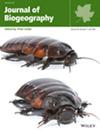Searchin' for Urchins: Utilising Museum Collections and Citizen Science to Assess Species on the Move in the Genus Tripneustes
Abstract
Aim
With the global redistribution of species due to warming, accurately quantifying species distributions is critical to understanding patterns in biodiversity and range shift trajectories. The genus Tripneustes comprises globally important sea urchin taxa that graze seagrass and macroalgae and have the potential to transform ecosystems. In eastern Australia, there are two Tripneustes taxa, the tropical T. g. gratilla and the subtropical-temperate T. australiae. The temperate distribution of T. australiae was considered to be a climate-driven range extension of T. g. gratilla until recent taxonomic clarification. We quantified the present and potential future distributions of these taxa in eastern Australia, a global warming hot spot.
Location
Eastern Australia and the Tasman Sea, including Lord Howe Island, Norfolk Island, and the north of New Zealand.
Taxon
Tripneustes (Echinodermata: Echinoidea: Toxopneustidae).
Methods
We reassessed specimen identifications across four museum collections to synthesise distribution data and citizen science observations, determining the biogeographic range and realised thermal niches of Tripneustes. Habitat suitability models were used to determine current suitable habitat and predict future distributional change.
Results
Whilst T. g. gratilla has a wide tropical-temperate distribution in the region from Papua New Guinea (9°56′2.4″ S) to Jervis Bay (35°7′12″ S) and a broad realised thermal niche (16.3°C–29.97°C), T. australiae has a subtropical-temperate distribution (Byron Bay, 28°37′0.12″ S, to Narooma, 36°15′0″ S) and a narrower thermal niche (15.3°C–26°C). Tripneustes densities were highest in the subtropical ecoregions, where the two taxa co-occur. Habitat suitability modelling indicated that T. australiae is a narrow-range thermal specialist that will likely undergo a poleward range shift by 2100. In contrast, T. g. gratilla is a generalist that appears capable of occupying a broader range of conditions.
Main Conclusions
Despite their similar ecological roles, congeneric Tripneustes in eastern Australia and the Tasman region have contrasting distributions and realised thermal niches, with distinct implications for their future distributions as the ocean warms.


 求助内容:
求助内容: 应助结果提醒方式:
应助结果提醒方式:


